Fixed Income Analysis and Trading Report - University Finance Module
VerifiedAdded on 2023/06/10
|8
|2650
|79
Report
AI Summary
This report provides a detailed analysis of fixed income analysis and trading. It begins with an introduction to fixed income analysis and its importance in assessing financial assets. The report then delves into how Porter's Five Forces impact capacity in credit risk analysis, examining the influence of competition, new entrants, suppliers, and customers. It further discusses credit scoring models, including pooled and custom models, parametric versus non-parametric models, and linear versus non-linear models, with examples. The report analyzes Alibaba's credit risks using the 4Cs of credit analysis, focusing on capacity and the challenges posed by increasing competition. The report also explains spread risk, its impact on Alibaba's inventory and supply, and the potential for increased costs and losses. The conclusion emphasizes the importance of credit risk management and the role of credit scoring models in mitigating potential financial threats. This report is a valuable resource for understanding the intricacies of fixed income analysis, credit risk, and their application in real-world scenarios.
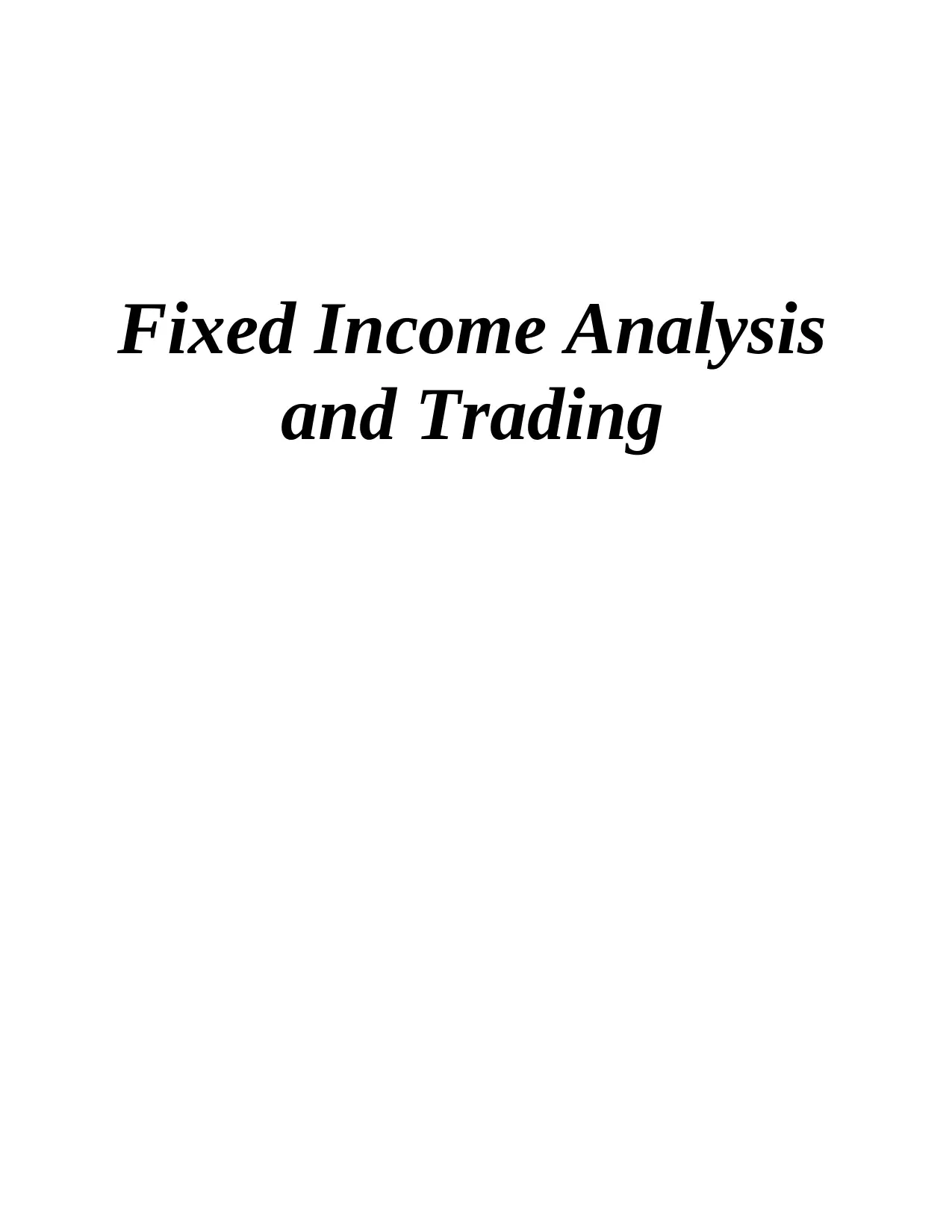
Fixed Income Analysis
and Trading
and Trading
Paraphrase This Document
Need a fresh take? Get an instant paraphrase of this document with our AI Paraphraser
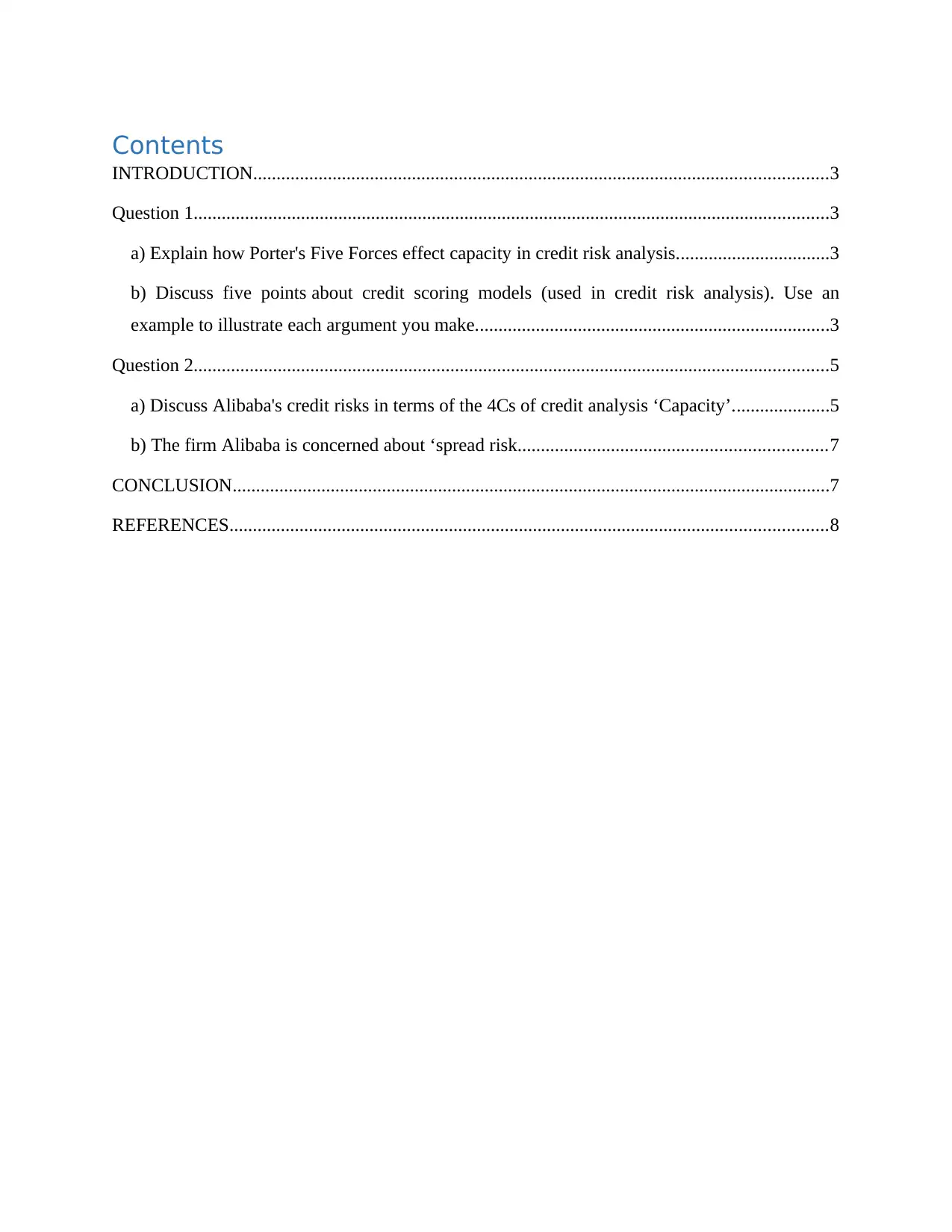
Contents
INTRODUCTION...........................................................................................................................3
Question 1........................................................................................................................................3
a) Explain how Porter's Five Forces effect capacity in credit risk analysis.................................3
b) Discuss five points about credit scoring models (used in credit risk analysis). Use an
example to illustrate each argument you make............................................................................3
Question 2........................................................................................................................................5
a) Discuss Alibaba's credit risks in terms of the 4Cs of credit analysis ‘Capacity’.....................5
b) The firm Alibaba is concerned about ‘spread risk..................................................................7
CONCLUSION................................................................................................................................7
REFERENCES................................................................................................................................8
INTRODUCTION...........................................................................................................................3
Question 1........................................................................................................................................3
a) Explain how Porter's Five Forces effect capacity in credit risk analysis.................................3
b) Discuss five points about credit scoring models (used in credit risk analysis). Use an
example to illustrate each argument you make............................................................................3
Question 2........................................................................................................................................5
a) Discuss Alibaba's credit risks in terms of the 4Cs of credit analysis ‘Capacity’.....................5
b) The firm Alibaba is concerned about ‘spread risk..................................................................7
CONCLUSION................................................................................................................................7
REFERENCES................................................................................................................................8
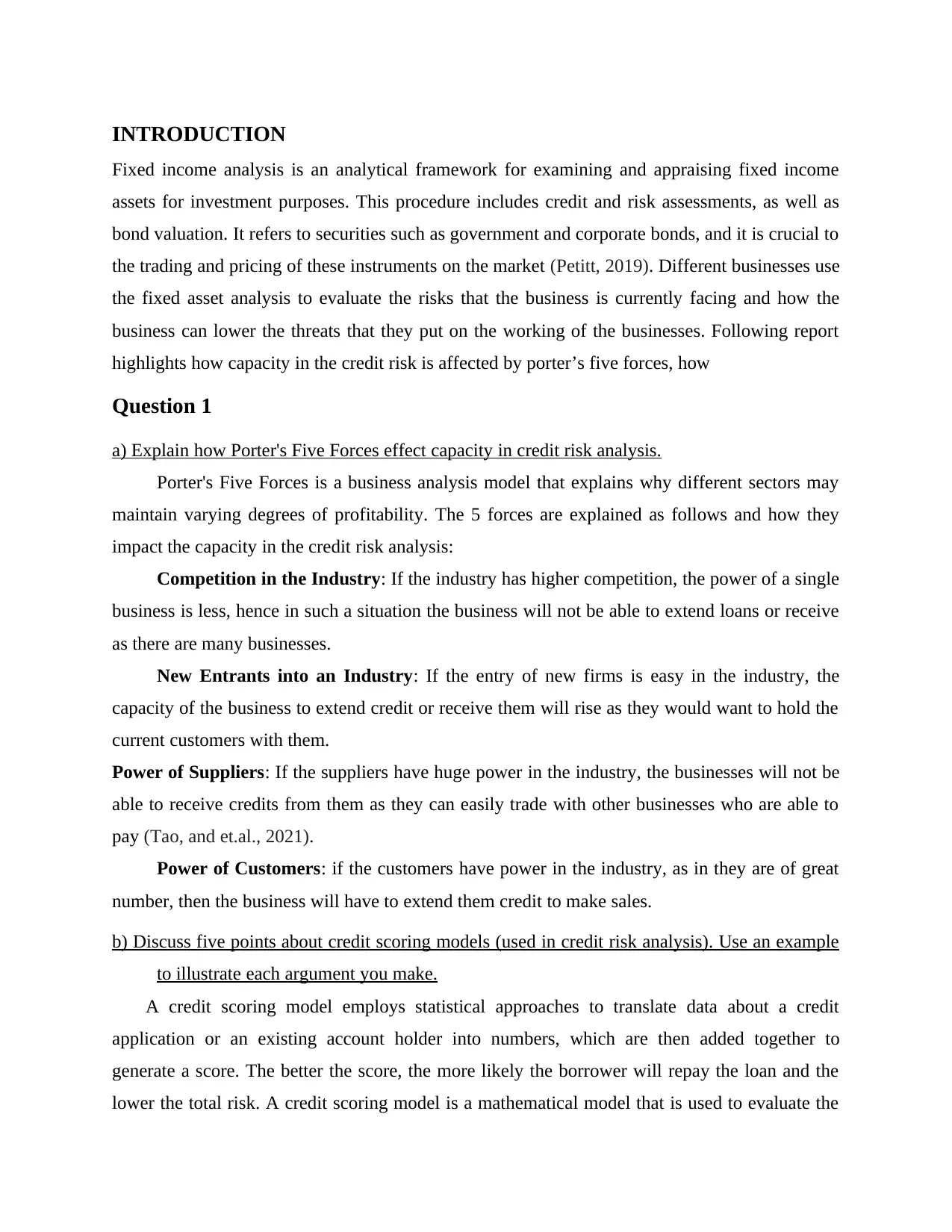
INTRODUCTION
Fixed income analysis is an analytical framework for examining and appraising fixed income
assets for investment purposes. This procedure includes credit and risk assessments, as well as
bond valuation. It refers to securities such as government and corporate bonds, and it is crucial to
the trading and pricing of these instruments on the market (Petitt, 2019). Different businesses use
the fixed asset analysis to evaluate the risks that the business is currently facing and how the
business can lower the threats that they put on the working of the businesses. Following report
highlights how capacity in the credit risk is affected by porter’s five forces, how
Question 1
a) Explain how Porter's Five Forces effect capacity in credit risk analysis.
Porter's Five Forces is a business analysis model that explains why different sectors may
maintain varying degrees of profitability. The 5 forces are explained as follows and how they
impact the capacity in the credit risk analysis:
Competition in the Industry: If the industry has higher competition, the power of a single
business is less, hence in such a situation the business will not be able to extend loans or receive
as there are many businesses.
New Entrants into an Industry: If the entry of new firms is easy in the industry, the
capacity of the business to extend credit or receive them will rise as they would want to hold the
current customers with them.
Power of Suppliers: If the suppliers have huge power in the industry, the businesses will not be
able to receive credits from them as they can easily trade with other businesses who are able to
pay (Tao, and et.al., 2021).
Power of Customers: if the customers have power in the industry, as in they are of great
number, then the business will have to extend them credit to make sales.
b) Discuss five points about credit scoring models (used in credit risk analysis). Use an example
to illustrate each argument you make.
A credit scoring model employs statistical approaches to translate data about a credit
application or an existing account holder into numbers, which are then added together to
generate a score. The better the score, the more likely the borrower will repay the loan and the
lower the total risk. A credit scoring model is a mathematical model that is used to evaluate the
Fixed income analysis is an analytical framework for examining and appraising fixed income
assets for investment purposes. This procedure includes credit and risk assessments, as well as
bond valuation. It refers to securities such as government and corporate bonds, and it is crucial to
the trading and pricing of these instruments on the market (Petitt, 2019). Different businesses use
the fixed asset analysis to evaluate the risks that the business is currently facing and how the
business can lower the threats that they put on the working of the businesses. Following report
highlights how capacity in the credit risk is affected by porter’s five forces, how
Question 1
a) Explain how Porter's Five Forces effect capacity in credit risk analysis.
Porter's Five Forces is a business analysis model that explains why different sectors may
maintain varying degrees of profitability. The 5 forces are explained as follows and how they
impact the capacity in the credit risk analysis:
Competition in the Industry: If the industry has higher competition, the power of a single
business is less, hence in such a situation the business will not be able to extend loans or receive
as there are many businesses.
New Entrants into an Industry: If the entry of new firms is easy in the industry, the
capacity of the business to extend credit or receive them will rise as they would want to hold the
current customers with them.
Power of Suppliers: If the suppliers have huge power in the industry, the businesses will not be
able to receive credits from them as they can easily trade with other businesses who are able to
pay (Tao, and et.al., 2021).
Power of Customers: if the customers have power in the industry, as in they are of great
number, then the business will have to extend them credit to make sales.
b) Discuss five points about credit scoring models (used in credit risk analysis). Use an example
to illustrate each argument you make.
A credit scoring model employs statistical approaches to translate data about a credit
application or an existing account holder into numbers, which are then added together to
generate a score. The better the score, the more likely the borrower will repay the loan and the
lower the total risk. A credit scoring model is a mathematical model that is used to evaluate the
⊘ This is a preview!⊘
Do you want full access?
Subscribe today to unlock all pages.

Trusted by 1+ million students worldwide
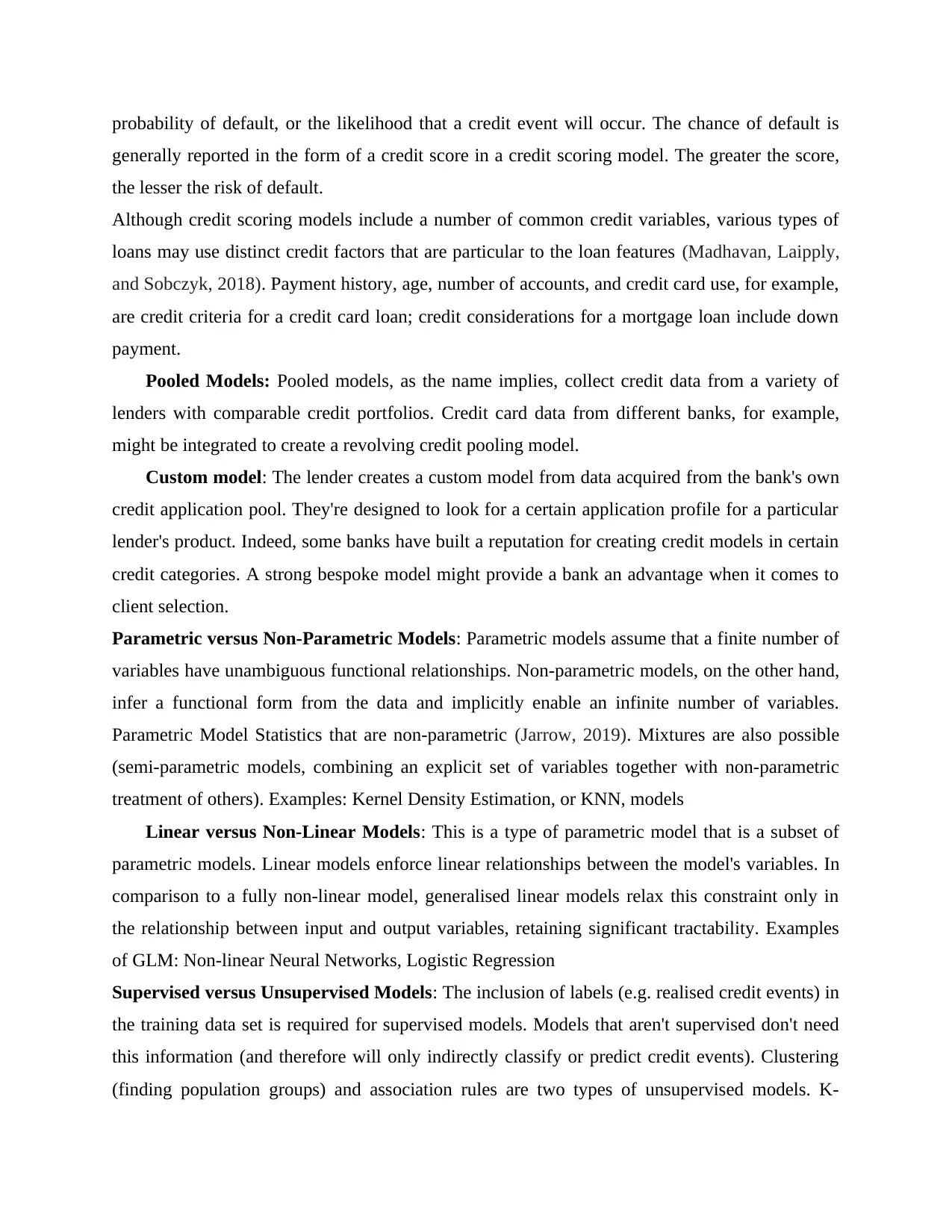
probability of default, or the likelihood that a credit event will occur. The chance of default is
generally reported in the form of a credit score in a credit scoring model. The greater the score,
the lesser the risk of default.
Although credit scoring models include a number of common credit variables, various types of
loans may use distinct credit factors that are particular to the loan features (Madhavan, Laipply,
and Sobczyk, 2018). Payment history, age, number of accounts, and credit card use, for example,
are credit criteria for a credit card loan; credit considerations for a mortgage loan include down
payment.
Pooled Models: Pooled models, as the name implies, collect credit data from a variety of
lenders with comparable credit portfolios. Credit card data from different banks, for example,
might be integrated to create a revolving credit pooling model.
Custom model: The lender creates a custom model from data acquired from the bank's own
credit application pool. They're designed to look for a certain application profile for a particular
lender's product. Indeed, some banks have built a reputation for creating credit models in certain
credit categories. A strong bespoke model might provide a bank an advantage when it comes to
client selection.
Parametric versus Non-Parametric Models: Parametric models assume that a finite number of
variables have unambiguous functional relationships. Non-parametric models, on the other hand,
infer a functional form from the data and implicitly enable an infinite number of variables.
Parametric Model Statistics that are non-parametric (Jarrow, 2019). Mixtures are also possible
(semi-parametric models, combining an explicit set of variables together with non-parametric
treatment of others). Examples: Kernel Density Estimation, or KNN, models
Linear versus Non-Linear Models: This is a type of parametric model that is a subset of
parametric models. Linear models enforce linear relationships between the model's variables. In
comparison to a fully non-linear model, generalised linear models relax this constraint only in
the relationship between input and output variables, retaining significant tractability. Examples
of GLM: Non-linear Neural Networks, Logistic Regression
Supervised versus Unsupervised Models: The inclusion of labels (e.g. realised credit events) in
the training data set is required for supervised models. Models that aren't supervised don't need
this information (and therefore will only indirectly classify or predict credit events). Clustering
(finding population groups) and association rules are two types of unsupervised models. K-
generally reported in the form of a credit score in a credit scoring model. The greater the score,
the lesser the risk of default.
Although credit scoring models include a number of common credit variables, various types of
loans may use distinct credit factors that are particular to the loan features (Madhavan, Laipply,
and Sobczyk, 2018). Payment history, age, number of accounts, and credit card use, for example,
are credit criteria for a credit card loan; credit considerations for a mortgage loan include down
payment.
Pooled Models: Pooled models, as the name implies, collect credit data from a variety of
lenders with comparable credit portfolios. Credit card data from different banks, for example,
might be integrated to create a revolving credit pooling model.
Custom model: The lender creates a custom model from data acquired from the bank's own
credit application pool. They're designed to look for a certain application profile for a particular
lender's product. Indeed, some banks have built a reputation for creating credit models in certain
credit categories. A strong bespoke model might provide a bank an advantage when it comes to
client selection.
Parametric versus Non-Parametric Models: Parametric models assume that a finite number of
variables have unambiguous functional relationships. Non-parametric models, on the other hand,
infer a functional form from the data and implicitly enable an infinite number of variables.
Parametric Model Statistics that are non-parametric (Jarrow, 2019). Mixtures are also possible
(semi-parametric models, combining an explicit set of variables together with non-parametric
treatment of others). Examples: Kernel Density Estimation, or KNN, models
Linear versus Non-Linear Models: This is a type of parametric model that is a subset of
parametric models. Linear models enforce linear relationships between the model's variables. In
comparison to a fully non-linear model, generalised linear models relax this constraint only in
the relationship between input and output variables, retaining significant tractability. Examples
of GLM: Non-linear Neural Networks, Logistic Regression
Supervised versus Unsupervised Models: The inclusion of labels (e.g. realised credit events) in
the training data set is required for supervised models. Models that aren't supervised don't need
this information (and therefore will only indirectly classify or predict credit events). Clustering
(finding population groups) and association rules are two types of unsupervised models. K-
Paraphrase This Document
Need a fresh take? Get an instant paraphrase of this document with our AI Paraphraser
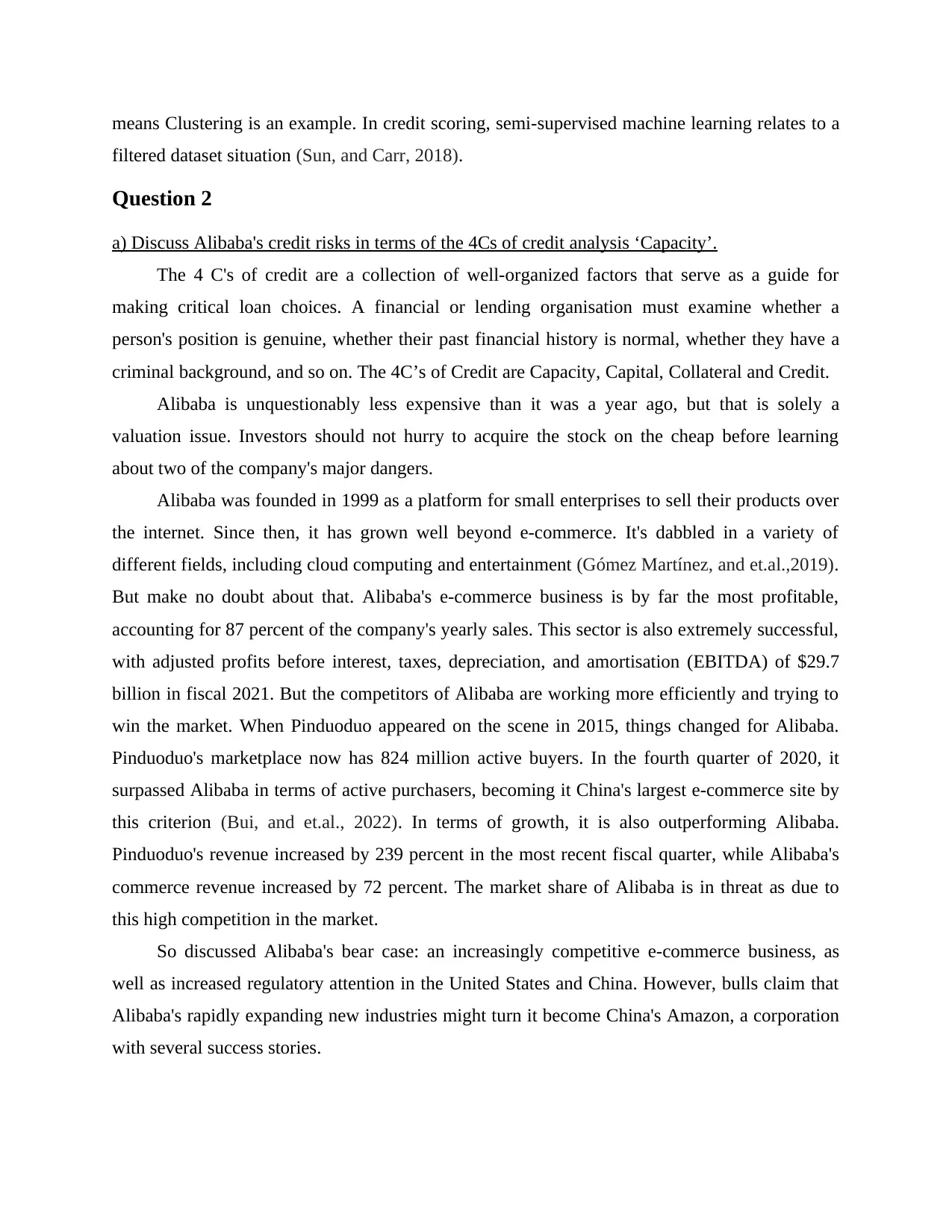
means Clustering is an example. In credit scoring, semi-supervised machine learning relates to a
filtered dataset situation (Sun, and Carr, 2018).
Question 2
a) Discuss Alibaba's credit risks in terms of the 4Cs of credit analysis ‘Capacity’.
The 4 C's of credit are a collection of well-organized factors that serve as a guide for
making critical loan choices. A financial or lending organisation must examine whether a
person's position is genuine, whether their past financial history is normal, whether they have a
criminal background, and so on. The 4C’s of Credit are Capacity, Capital, Collateral and Credit.
Alibaba is unquestionably less expensive than it was a year ago, but that is solely a
valuation issue. Investors should not hurry to acquire the stock on the cheap before learning
about two of the company's major dangers.
Alibaba was founded in 1999 as a platform for small enterprises to sell their products over
the internet. Since then, it has grown well beyond e-commerce. It's dabbled in a variety of
different fields, including cloud computing and entertainment (Gómez Martínez, and et.al.,2019).
But make no doubt about that. Alibaba's e-commerce business is by far the most profitable,
accounting for 87 percent of the company's yearly sales. This sector is also extremely successful,
with adjusted profits before interest, taxes, depreciation, and amortisation (EBITDA) of $29.7
billion in fiscal 2021. But the competitors of Alibaba are working more efficiently and trying to
win the market. When Pinduoduo appeared on the scene in 2015, things changed for Alibaba.
Pinduoduo's marketplace now has 824 million active buyers. In the fourth quarter of 2020, it
surpassed Alibaba in terms of active purchasers, becoming it China's largest e-commerce site by
this criterion (Bui, and et.al., 2022). In terms of growth, it is also outperforming Alibaba.
Pinduoduo's revenue increased by 239 percent in the most recent fiscal quarter, while Alibaba's
commerce revenue increased by 72 percent. The market share of Alibaba is in threat as due to
this high competition in the market.
So discussed Alibaba's bear case: an increasingly competitive e-commerce business, as
well as increased regulatory attention in the United States and China. However, bulls claim that
Alibaba's rapidly expanding new industries might turn it become China's Amazon, a corporation
with several success stories.
filtered dataset situation (Sun, and Carr, 2018).
Question 2
a) Discuss Alibaba's credit risks in terms of the 4Cs of credit analysis ‘Capacity’.
The 4 C's of credit are a collection of well-organized factors that serve as a guide for
making critical loan choices. A financial or lending organisation must examine whether a
person's position is genuine, whether their past financial history is normal, whether they have a
criminal background, and so on. The 4C’s of Credit are Capacity, Capital, Collateral and Credit.
Alibaba is unquestionably less expensive than it was a year ago, but that is solely a
valuation issue. Investors should not hurry to acquire the stock on the cheap before learning
about two of the company's major dangers.
Alibaba was founded in 1999 as a platform for small enterprises to sell their products over
the internet. Since then, it has grown well beyond e-commerce. It's dabbled in a variety of
different fields, including cloud computing and entertainment (Gómez Martínez, and et.al.,2019).
But make no doubt about that. Alibaba's e-commerce business is by far the most profitable,
accounting for 87 percent of the company's yearly sales. This sector is also extremely successful,
with adjusted profits before interest, taxes, depreciation, and amortisation (EBITDA) of $29.7
billion in fiscal 2021. But the competitors of Alibaba are working more efficiently and trying to
win the market. When Pinduoduo appeared on the scene in 2015, things changed for Alibaba.
Pinduoduo's marketplace now has 824 million active buyers. In the fourth quarter of 2020, it
surpassed Alibaba in terms of active purchasers, becoming it China's largest e-commerce site by
this criterion (Bui, and et.al., 2022). In terms of growth, it is also outperforming Alibaba.
Pinduoduo's revenue increased by 239 percent in the most recent fiscal quarter, while Alibaba's
commerce revenue increased by 72 percent. The market share of Alibaba is in threat as due to
this high competition in the market.
So discussed Alibaba's bear case: an increasingly competitive e-commerce business, as
well as increased regulatory attention in the United States and China. However, bulls claim that
Alibaba's rapidly expanding new industries might turn it become China's Amazon, a corporation
with several success stories.
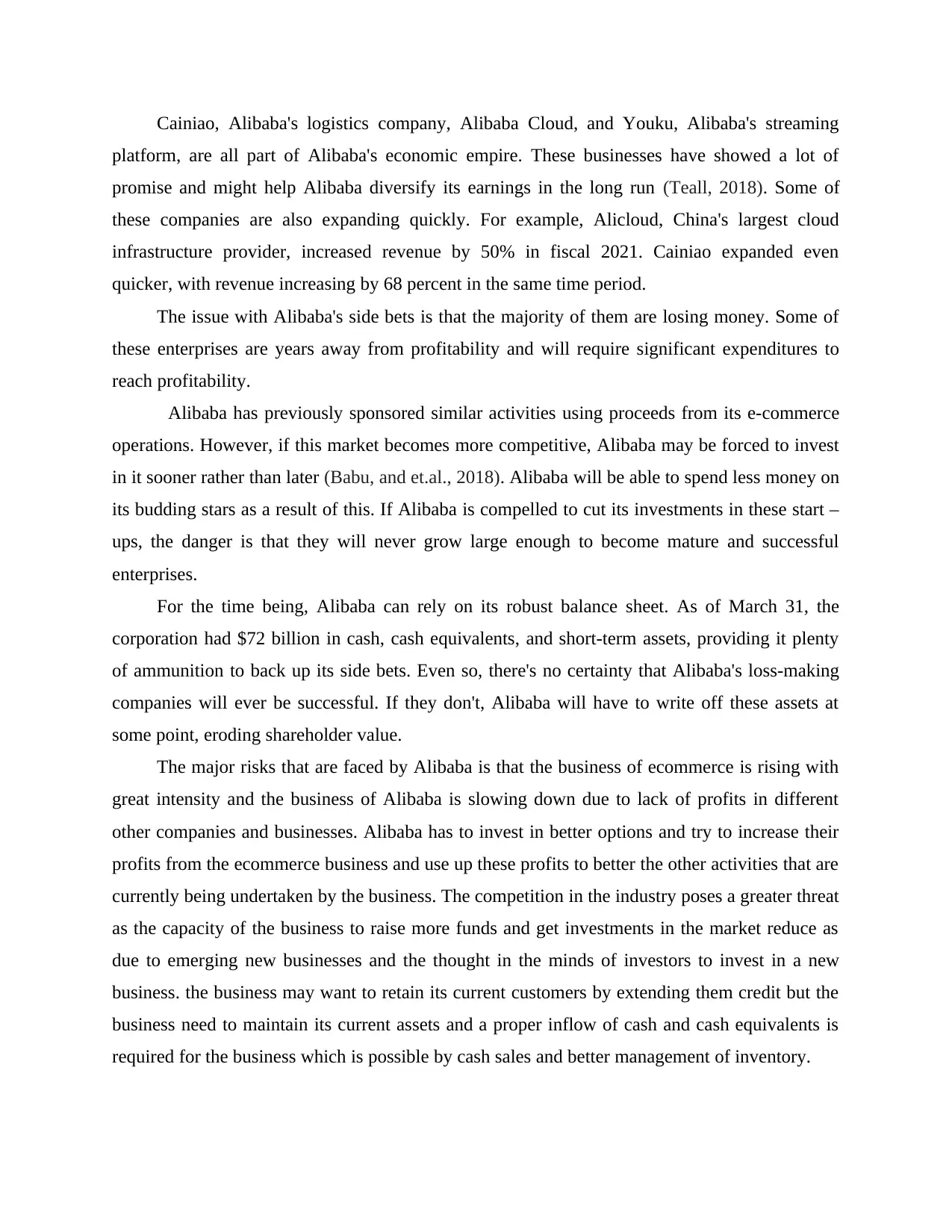
Cainiao, Alibaba's logistics company, Alibaba Cloud, and Youku, Alibaba's streaming
platform, are all part of Alibaba's economic empire. These businesses have showed a lot of
promise and might help Alibaba diversify its earnings in the long run (Teall, 2018). Some of
these companies are also expanding quickly. For example, Alicloud, China's largest cloud
infrastructure provider, increased revenue by 50% in fiscal 2021. Cainiao expanded even
quicker, with revenue increasing by 68 percent in the same time period.
The issue with Alibaba's side bets is that the majority of them are losing money. Some of
these enterprises are years away from profitability and will require significant expenditures to
reach profitability.
Alibaba has previously sponsored similar activities using proceeds from its e-commerce
operations. However, if this market becomes more competitive, Alibaba may be forced to invest
in it sooner rather than later (Babu, and et.al., 2018). Alibaba will be able to spend less money on
its budding stars as a result of this. If Alibaba is compelled to cut its investments in these start –
ups, the danger is that they will never grow large enough to become mature and successful
enterprises.
For the time being, Alibaba can rely on its robust balance sheet. As of March 31, the
corporation had $72 billion in cash, cash equivalents, and short-term assets, providing it plenty
of ammunition to back up its side bets. Even so, there's no certainty that Alibaba's loss-making
companies will ever be successful. If they don't, Alibaba will have to write off these assets at
some point, eroding shareholder value.
The major risks that are faced by Alibaba is that the business of ecommerce is rising with
great intensity and the business of Alibaba is slowing down due to lack of profits in different
other companies and businesses. Alibaba has to invest in better options and try to increase their
profits from the ecommerce business and use up these profits to better the other activities that are
currently being undertaken by the business. The competition in the industry poses a greater threat
as the capacity of the business to raise more funds and get investments in the market reduce as
due to emerging new businesses and the thought in the minds of investors to invest in a new
business. the business may want to retain its current customers by extending them credit but the
business need to maintain its current assets and a proper inflow of cash and cash equivalents is
required for the business which is possible by cash sales and better management of inventory.
platform, are all part of Alibaba's economic empire. These businesses have showed a lot of
promise and might help Alibaba diversify its earnings in the long run (Teall, 2018). Some of
these companies are also expanding quickly. For example, Alicloud, China's largest cloud
infrastructure provider, increased revenue by 50% in fiscal 2021. Cainiao expanded even
quicker, with revenue increasing by 68 percent in the same time period.
The issue with Alibaba's side bets is that the majority of them are losing money. Some of
these enterprises are years away from profitability and will require significant expenditures to
reach profitability.
Alibaba has previously sponsored similar activities using proceeds from its e-commerce
operations. However, if this market becomes more competitive, Alibaba may be forced to invest
in it sooner rather than later (Babu, and et.al., 2018). Alibaba will be able to spend less money on
its budding stars as a result of this. If Alibaba is compelled to cut its investments in these start –
ups, the danger is that they will never grow large enough to become mature and successful
enterprises.
For the time being, Alibaba can rely on its robust balance sheet. As of March 31, the
corporation had $72 billion in cash, cash equivalents, and short-term assets, providing it plenty
of ammunition to back up its side bets. Even so, there's no certainty that Alibaba's loss-making
companies will ever be successful. If they don't, Alibaba will have to write off these assets at
some point, eroding shareholder value.
The major risks that are faced by Alibaba is that the business of ecommerce is rising with
great intensity and the business of Alibaba is slowing down due to lack of profits in different
other companies and businesses. Alibaba has to invest in better options and try to increase their
profits from the ecommerce business and use up these profits to better the other activities that are
currently being undertaken by the business. The competition in the industry poses a greater threat
as the capacity of the business to raise more funds and get investments in the market reduce as
due to emerging new businesses and the thought in the minds of investors to invest in a new
business. the business may want to retain its current customers by extending them credit but the
business need to maintain its current assets and a proper inflow of cash and cash equivalents is
required for the business which is possible by cash sales and better management of inventory.
⊘ This is a preview!⊘
Do you want full access?
Subscribe today to unlock all pages.

Trusted by 1+ million students worldwide
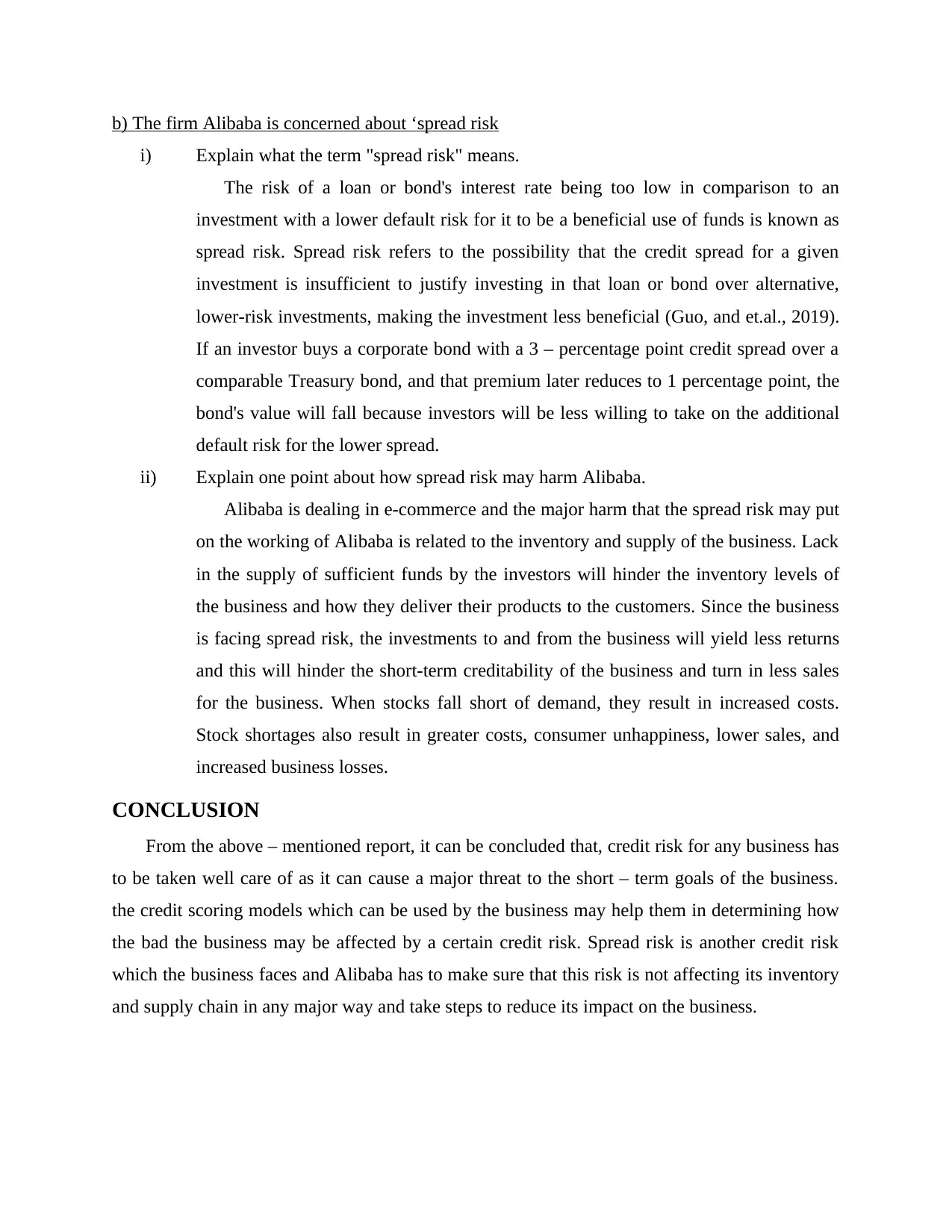
b) The firm Alibaba is concerned about ‘spread risk
i) Explain what the term "spread risk" means.
The risk of a loan or bond's interest rate being too low in comparison to an
investment with a lower default risk for it to be a beneficial use of funds is known as
spread risk. Spread risk refers to the possibility that the credit spread for a given
investment is insufficient to justify investing in that loan or bond over alternative,
lower-risk investments, making the investment less beneficial (Guo, and et.al., 2019).
If an investor buys a corporate bond with a 3 – percentage point credit spread over a
comparable Treasury bond, and that premium later reduces to 1 percentage point, the
bond's value will fall because investors will be less willing to take on the additional
default risk for the lower spread.
ii) Explain one point about how spread risk may harm Alibaba.
Alibaba is dealing in e-commerce and the major harm that the spread risk may put
on the working of Alibaba is related to the inventory and supply of the business. Lack
in the supply of sufficient funds by the investors will hinder the inventory levels of
the business and how they deliver their products to the customers. Since the business
is facing spread risk, the investments to and from the business will yield less returns
and this will hinder the short-term creditability of the business and turn in less sales
for the business. When stocks fall short of demand, they result in increased costs.
Stock shortages also result in greater costs, consumer unhappiness, lower sales, and
increased business losses.
CONCLUSION
From the above – mentioned report, it can be concluded that, credit risk for any business has
to be taken well care of as it can cause a major threat to the short – term goals of the business.
the credit scoring models which can be used by the business may help them in determining how
the bad the business may be affected by a certain credit risk. Spread risk is another credit risk
which the business faces and Alibaba has to make sure that this risk is not affecting its inventory
and supply chain in any major way and take steps to reduce its impact on the business.
i) Explain what the term "spread risk" means.
The risk of a loan or bond's interest rate being too low in comparison to an
investment with a lower default risk for it to be a beneficial use of funds is known as
spread risk. Spread risk refers to the possibility that the credit spread for a given
investment is insufficient to justify investing in that loan or bond over alternative,
lower-risk investments, making the investment less beneficial (Guo, and et.al., 2019).
If an investor buys a corporate bond with a 3 – percentage point credit spread over a
comparable Treasury bond, and that premium later reduces to 1 percentage point, the
bond's value will fall because investors will be less willing to take on the additional
default risk for the lower spread.
ii) Explain one point about how spread risk may harm Alibaba.
Alibaba is dealing in e-commerce and the major harm that the spread risk may put
on the working of Alibaba is related to the inventory and supply of the business. Lack
in the supply of sufficient funds by the investors will hinder the inventory levels of
the business and how they deliver their products to the customers. Since the business
is facing spread risk, the investments to and from the business will yield less returns
and this will hinder the short-term creditability of the business and turn in less sales
for the business. When stocks fall short of demand, they result in increased costs.
Stock shortages also result in greater costs, consumer unhappiness, lower sales, and
increased business losses.
CONCLUSION
From the above – mentioned report, it can be concluded that, credit risk for any business has
to be taken well care of as it can cause a major threat to the short – term goals of the business.
the credit scoring models which can be used by the business may help them in determining how
the bad the business may be affected by a certain credit risk. Spread risk is another credit risk
which the business faces and Alibaba has to make sure that this risk is not affecting its inventory
and supply chain in any major way and take steps to reduce its impact on the business.
Paraphrase This Document
Need a fresh take? Get an instant paraphrase of this document with our AI Paraphraser
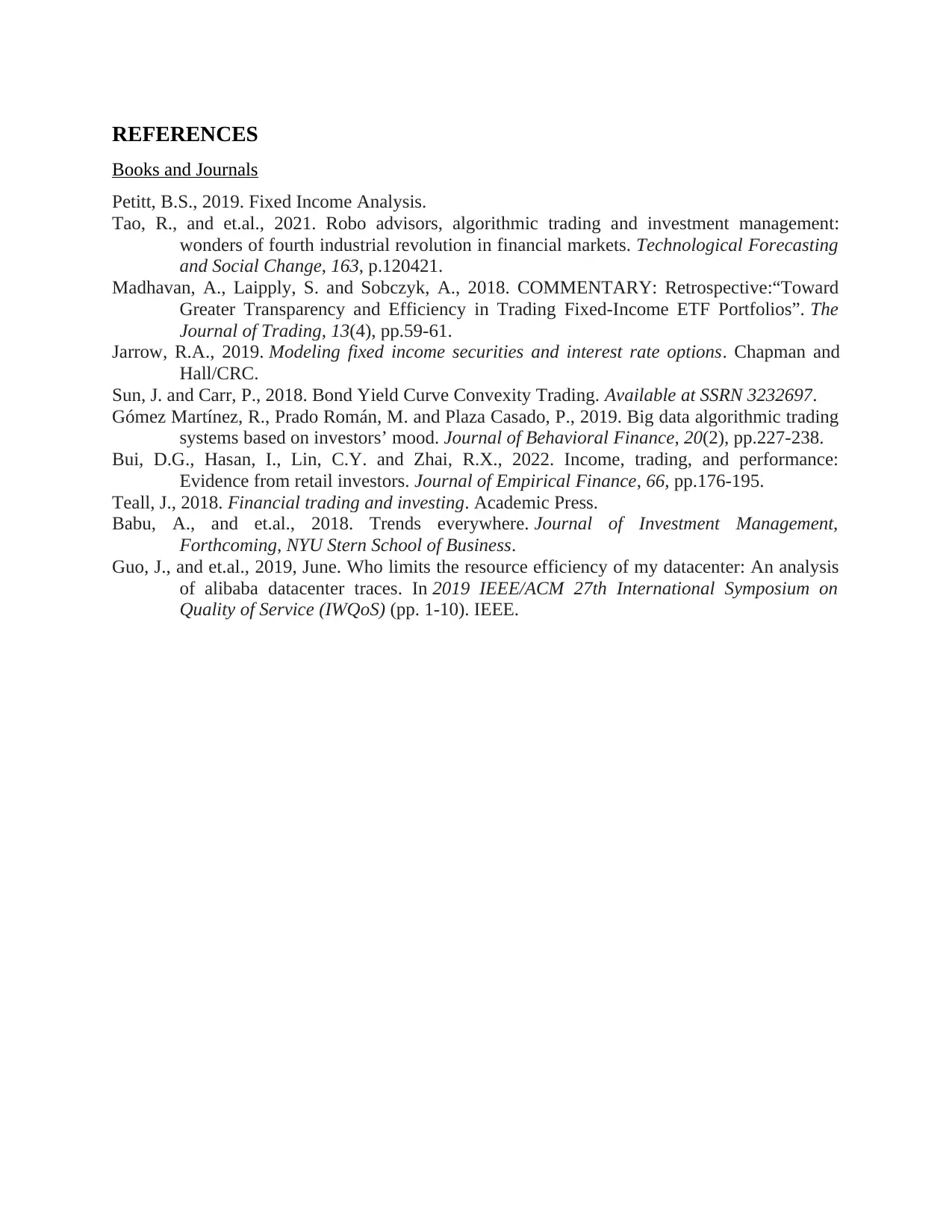
REFERENCES
Books and Journals
Petitt, B.S., 2019. Fixed Income Analysis.
Tao, R., and et.al., 2021. Robo advisors, algorithmic trading and investment management:
wonders of fourth industrial revolution in financial markets. Technological Forecasting
and Social Change, 163, p.120421.
Madhavan, A., Laipply, S. and Sobczyk, A., 2018. COMMENTARY: Retrospective:“Toward
Greater Transparency and Efficiency in Trading Fixed-Income ETF Portfolios”. The
Journal of Trading, 13(4), pp.59-61.
Jarrow, R.A., 2019. Modeling fixed income securities and interest rate options. Chapman and
Hall/CRC.
Sun, J. and Carr, P., 2018. Bond Yield Curve Convexity Trading. Available at SSRN 3232697.
Gómez Martínez, R., Prado Román, M. and Plaza Casado, P., 2019. Big data algorithmic trading
systems based on investors’ mood. Journal of Behavioral Finance, 20(2), pp.227-238.
Bui, D.G., Hasan, I., Lin, C.Y. and Zhai, R.X., 2022. Income, trading, and performance:
Evidence from retail investors. Journal of Empirical Finance, 66, pp.176-195.
Teall, J., 2018. Financial trading and investing. Academic Press.
Babu, A., and et.al., 2018. Trends everywhere. Journal of Investment Management,
Forthcoming, NYU Stern School of Business.
Guo, J., and et.al., 2019, June. Who limits the resource efficiency of my datacenter: An analysis
of alibaba datacenter traces. In 2019 IEEE/ACM 27th International Symposium on
Quality of Service (IWQoS) (pp. 1-10). IEEE.
Books and Journals
Petitt, B.S., 2019. Fixed Income Analysis.
Tao, R., and et.al., 2021. Robo advisors, algorithmic trading and investment management:
wonders of fourth industrial revolution in financial markets. Technological Forecasting
and Social Change, 163, p.120421.
Madhavan, A., Laipply, S. and Sobczyk, A., 2018. COMMENTARY: Retrospective:“Toward
Greater Transparency and Efficiency in Trading Fixed-Income ETF Portfolios”. The
Journal of Trading, 13(4), pp.59-61.
Jarrow, R.A., 2019. Modeling fixed income securities and interest rate options. Chapman and
Hall/CRC.
Sun, J. and Carr, P., 2018. Bond Yield Curve Convexity Trading. Available at SSRN 3232697.
Gómez Martínez, R., Prado Román, M. and Plaza Casado, P., 2019. Big data algorithmic trading
systems based on investors’ mood. Journal of Behavioral Finance, 20(2), pp.227-238.
Bui, D.G., Hasan, I., Lin, C.Y. and Zhai, R.X., 2022. Income, trading, and performance:
Evidence from retail investors. Journal of Empirical Finance, 66, pp.176-195.
Teall, J., 2018. Financial trading and investing. Academic Press.
Babu, A., and et.al., 2018. Trends everywhere. Journal of Investment Management,
Forthcoming, NYU Stern School of Business.
Guo, J., and et.al., 2019, June. Who limits the resource efficiency of my datacenter: An analysis
of alibaba datacenter traces. In 2019 IEEE/ACM 27th International Symposium on
Quality of Service (IWQoS) (pp. 1-10). IEEE.
1 out of 8
Related Documents
Your All-in-One AI-Powered Toolkit for Academic Success.
+13062052269
info@desklib.com
Available 24*7 on WhatsApp / Email
![[object Object]](/_next/static/media/star-bottom.7253800d.svg)
Unlock your academic potential
Copyright © 2020–2025 A2Z Services. All Rights Reserved. Developed and managed by ZUCOL.




